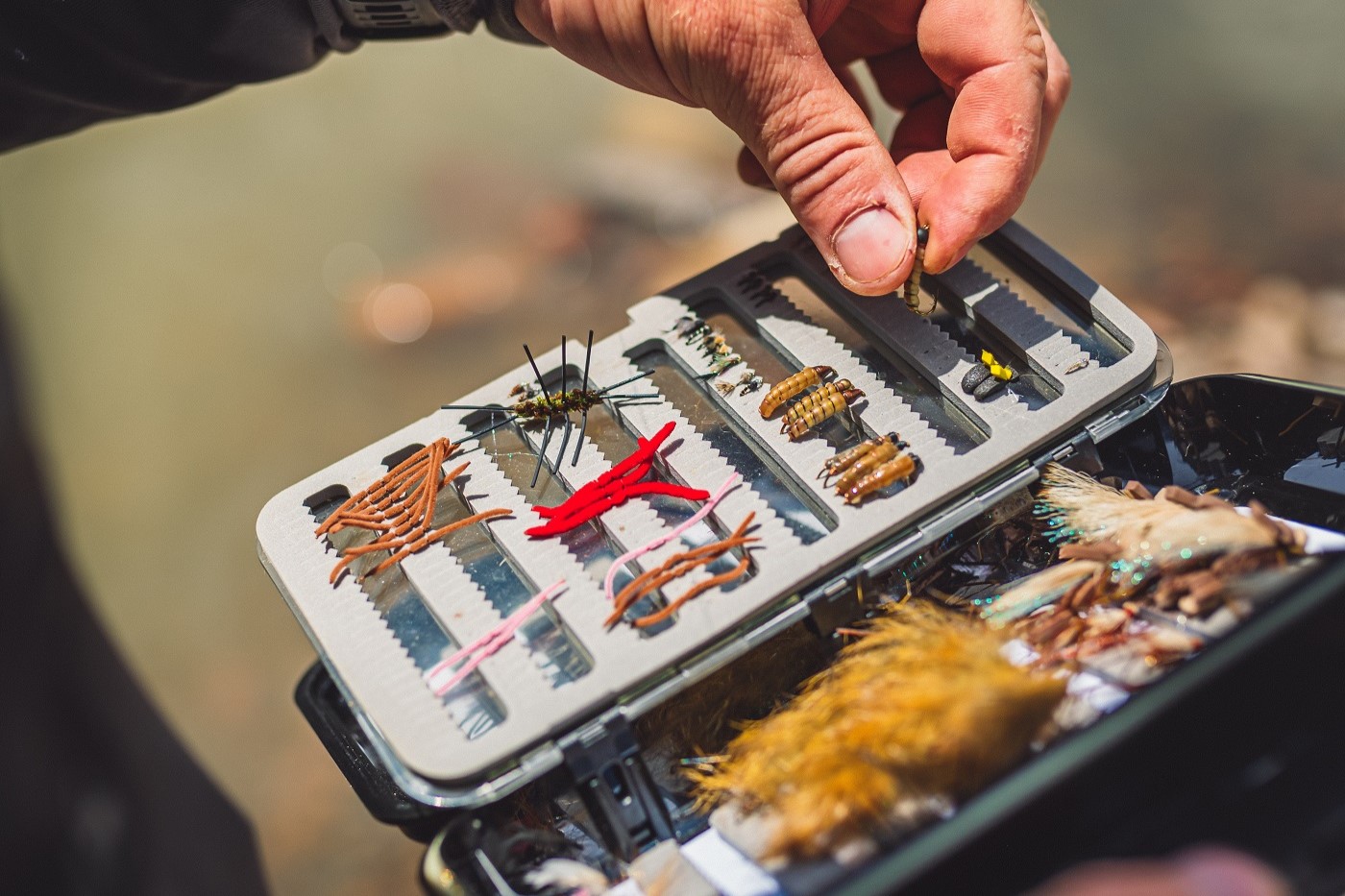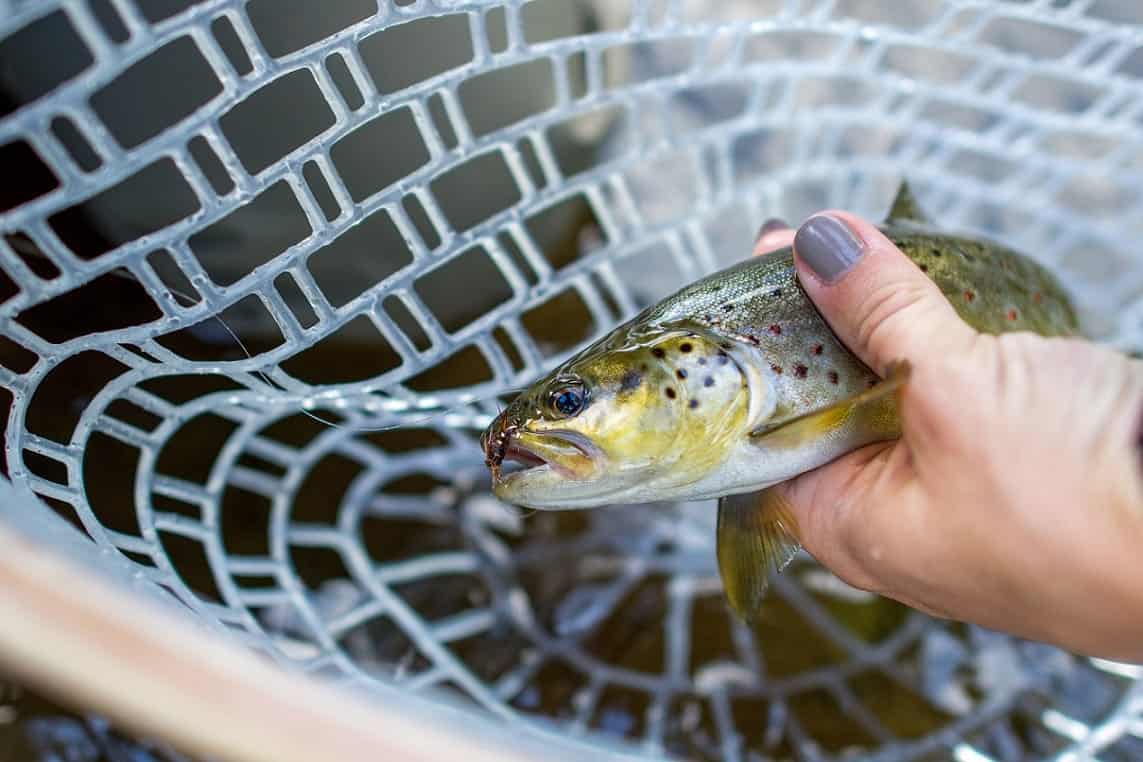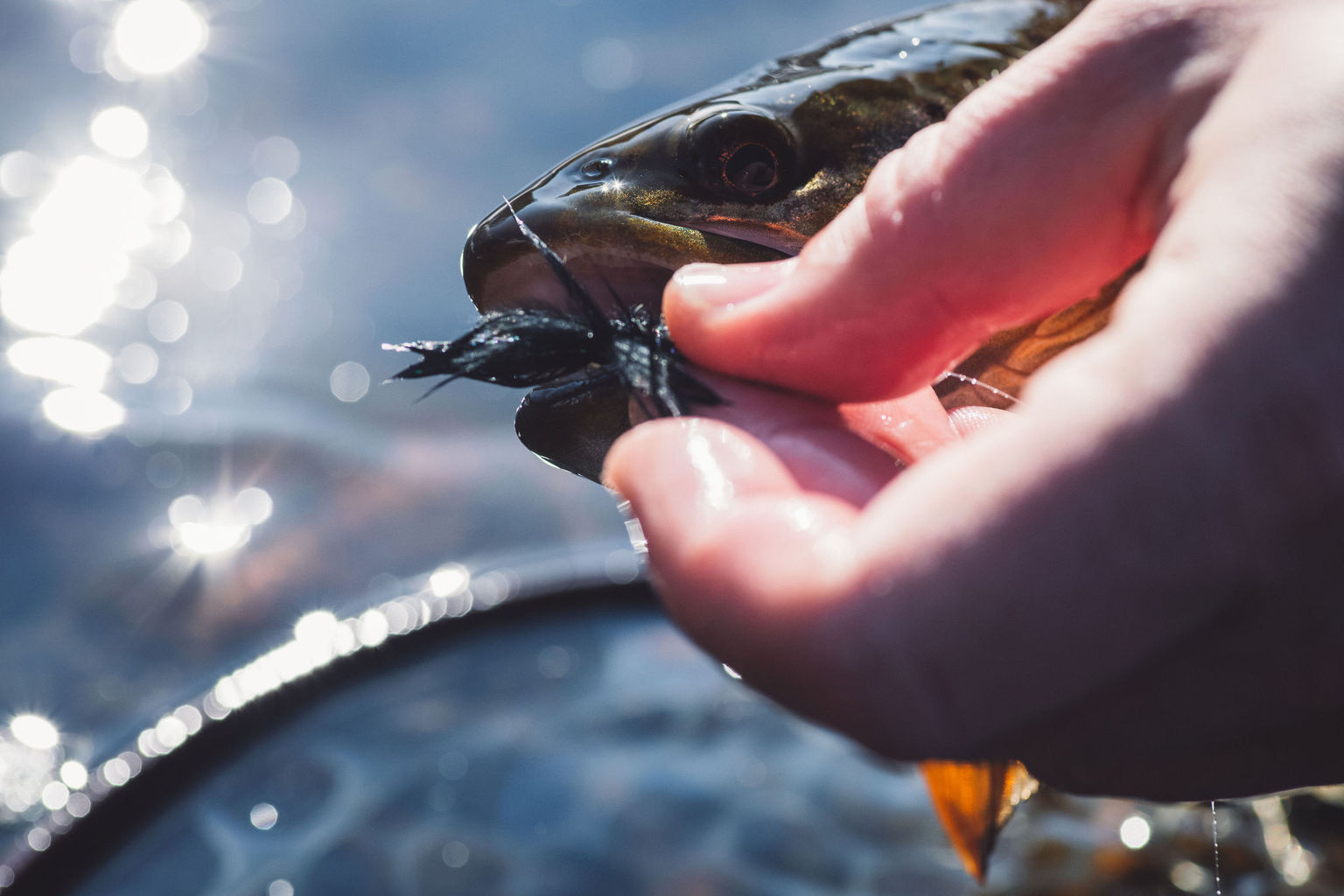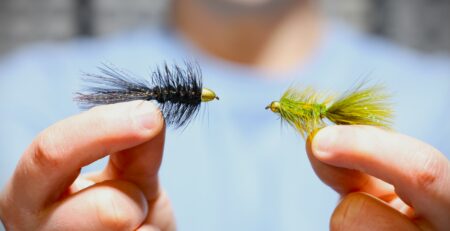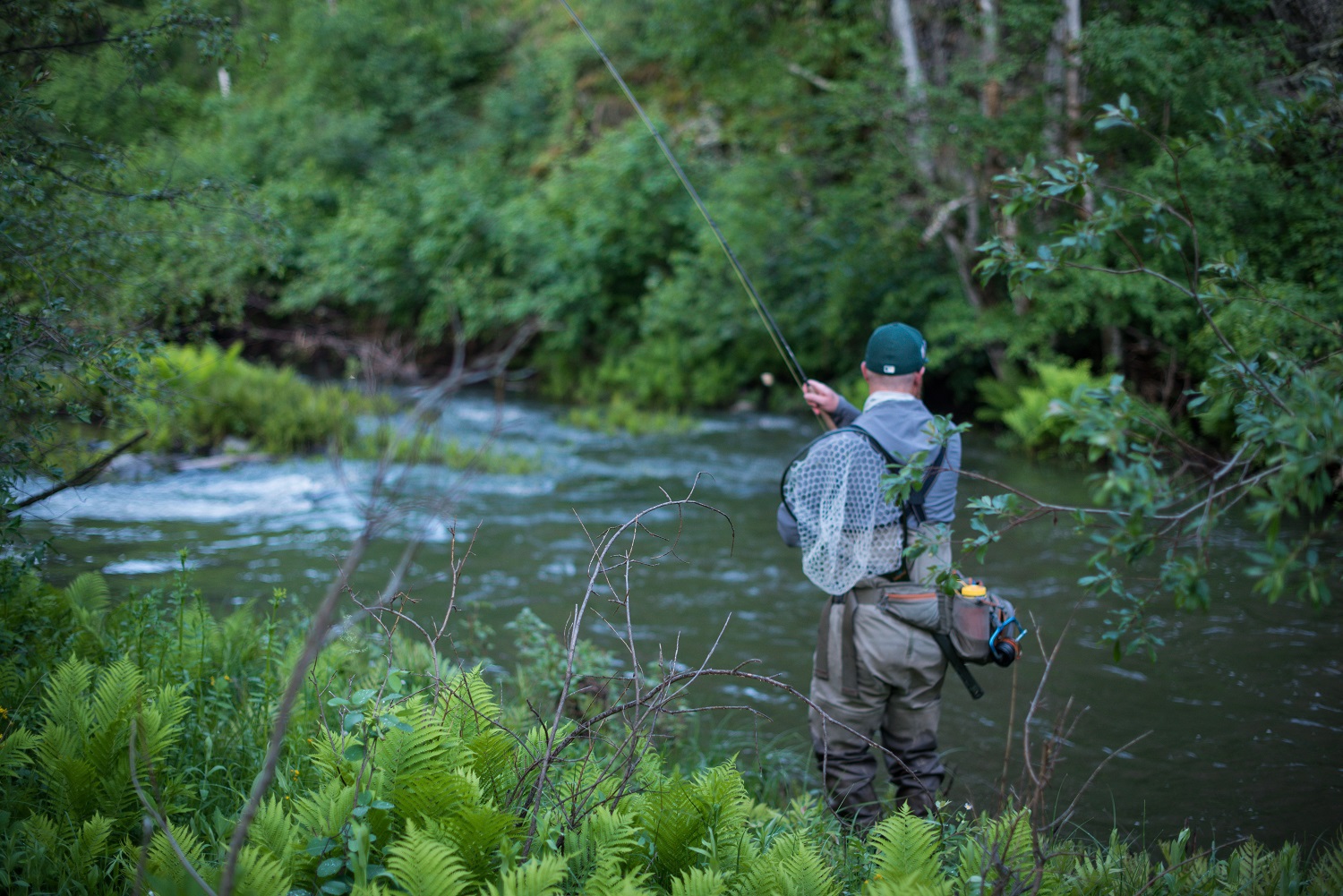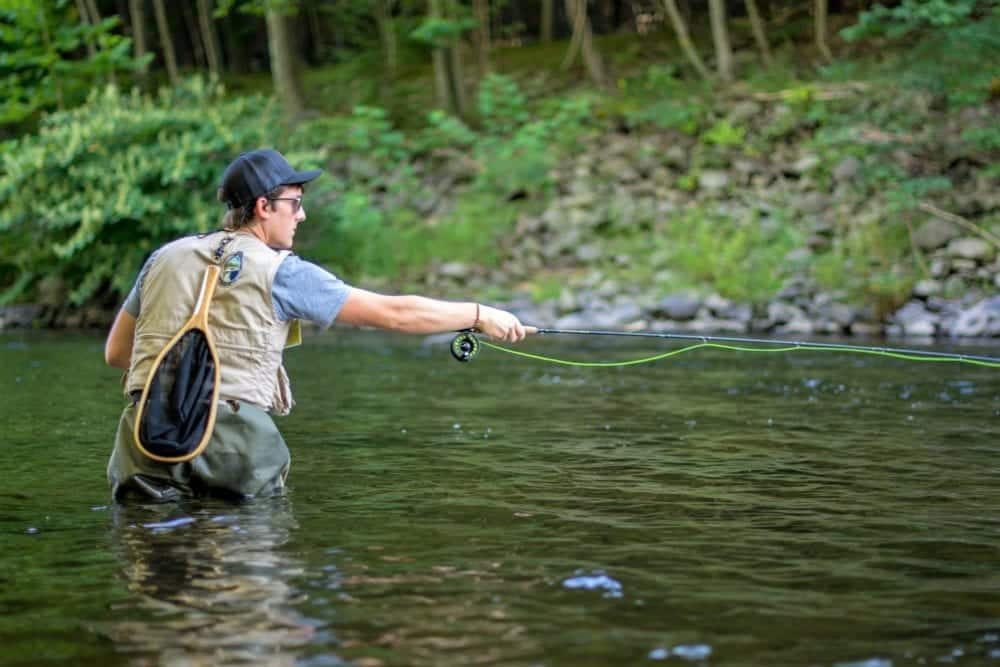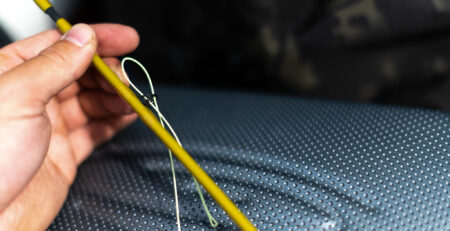4 Different Types of Fly Fishing Flies And How to Use Them
Entering a fly shop for the first time can be intimidating. I remember being new to the sport and feeling intimidated when entering fly shops. Although everybody in the fly shop was also once a beginner, too many times there seems to be at least one person who makes you feel less than inadequate when it comes to your fly fishing knowledge. Names dropped, the terminology you do not know, references to fishing techniques, and Latin etymological names can make most people feel inadequate to say the least. It can be overwhelming.
Choosing the right flies and understanding the purpose of fly patterns is a challenge. Just remembering the names can be difficult. After all, flies come in thousands of shapes, color, and sizes. How do you know how to choose the right types of fly fishing flies for where you are going to fly fish? Our goal here is to shed some light on when, where, and how you can approach selecting wet flies, nymphs, or dry flies for freshwater fishing.
If you are new to fly fishing, this is the good news: fish do not care about Latin names or classifications. Your local trout are not counting the number of tails your pheasant tail has versus the may fly hatching next to it. The most important details that a fly fisherman should pay attention to are the general life cycles of mayflies, caddis, midges, and stoneflies. If you understand general life cycles and bug behavior, it does not matter what is hatching. If you can identify the size, shape, and color of streamside insects then you can match the hatch.
Fly Fishing Made Easy 👍
Our Quarterly Fly Club ships 1,000’s of flies to anglers all across the United States. Receive curated fly assortments selected for the season with in-depth articles on how to fish them. Great for beginners to learn and for intermediates to discover new flies.
We are going to de-mystify fly selection and make it as straightforward as possible. As a guide, I can tell you that not all fly fishing flies are created equally. I separate my fly boxes into two general categories.
Category one is your classic patterns and the old standbys that I would never leave home without. These patterns can be fished anywhere anytime and are generally impressionistic. Impressionistic flies cover a wider range of different categories of aquatic insects.
The other half of my fly selection is hatch specific imitative fly patterns that are hot flies during the present hatch, or were effective the previous guide season. There is something to be said about new patterns. I have witnessed it myself on heavily pressured rivers. New fly patterns that fish have not seen work very well. They are extremely effective for a few seasons. As our sport is pushed forward by innovative materials or fly pattern that works better than the last one, it provides anglers the opportunity to fish new flies. Imitative flies are important and we will cover them accordingly.
We will cover:
- The 4 Different Fly Types
- How to Understand Aquatic Insect Lifecycles and Apply Them to Fly Fishing
- How to Determine What Trout are Eating
- What Flies Should I Choose for My Fly Box
The 4 Different Types of Fly Fishing Flies
There are four main different types of flies in fly fishing: nymphs or wet flies, emergers, streamers, and dry flies. Each has very specific uses and insect life stages that they help you imitate. So we are all on the same page and understand the difference between a wet fly and a dry fly I will define what the terminology means.
Here are the 4 different types of fly fishing flies and how to use them.

Nymph or Wet Fly
Nymphs and wet flies are fly fishing flies that are fished subsurface. In simplistic terms, a nymph fly is a type of fly fishing fly that imitates the naturally occurring insect larva and nymphal stages of aquatic insects commonly found in streams, rivers, ponds, and lakes. These nymphal or larvae stages are the beginning stages of an aquatic insect after they hatch from their eggs.
Nymphs are commonly found under or on rocks, in aquatic vegetation, fallen tree branches in the water, and even in gravel, sand, or loose sediment. They do not have wings nor can they fly in this insect stage. Instead, they scavenge and hunt for food by crawling along the streambed, which means they constantly live underwater. Because of this, all nymph patterns found in fly fishing are used to sink and to be fished under the water. Nymphs are actually a subcategory of wet flies. In the family tree of fly fishing flies, it splits off into wet flies and dry flies, which nymph patterns fall under the wet fly category because they sink.
Usually, we fly anglers’ fish nymphs in what we call a ‘dead-drift’, which imitates when insect nymphs and larvae are pushed loose from their rocky crevices and tumble along the bottom of the river, moving at the same speed as the water current.
Recommended Reading: 15 Useful Explanations That Make Nymph Fly Fishing Stupid Simple

Emergers
Emerger flies are subsurface fly fishing flies that are lightweight and are designed to be fished just below the surface or in the surface film. They are imitating the insect life stage where bugs are trying to break through the surface of the water after molting from their nymphal or larva stage.
Recommended Reading: What’s An Emerger Fly and How Do I Use Them?

Dry Fly
Dry flies are a category of fly fishing flies that are designed to float either on the surface or within the surface film and imitate insects such as mayflies, caddisflies, stoneflies, midges, grasshoppers, and ants. They typically have a wing, post, or buoyant body that helps them float. Usually, dry flies imitate the adult flying form of the insect.
Dry flies are very different than wet flies and nymphs. They are a category of fly fishing flies designed to float while wet flies and nymphs sink. Dry flies are usually made with lighter weight hooks, palmered chicken hackle, and buoyant animal hair such as deer hair, elk, or snowshoe. A telltale sign that a fishing fly is a dry fly is by its weight and shape. Nymphs and wet flies tend to have thicker hooks, beads, densely packed bodies, and no means of supporting itself above the surface.
Recommended Reading: How to Fly Fish With Dry Flies For Trout
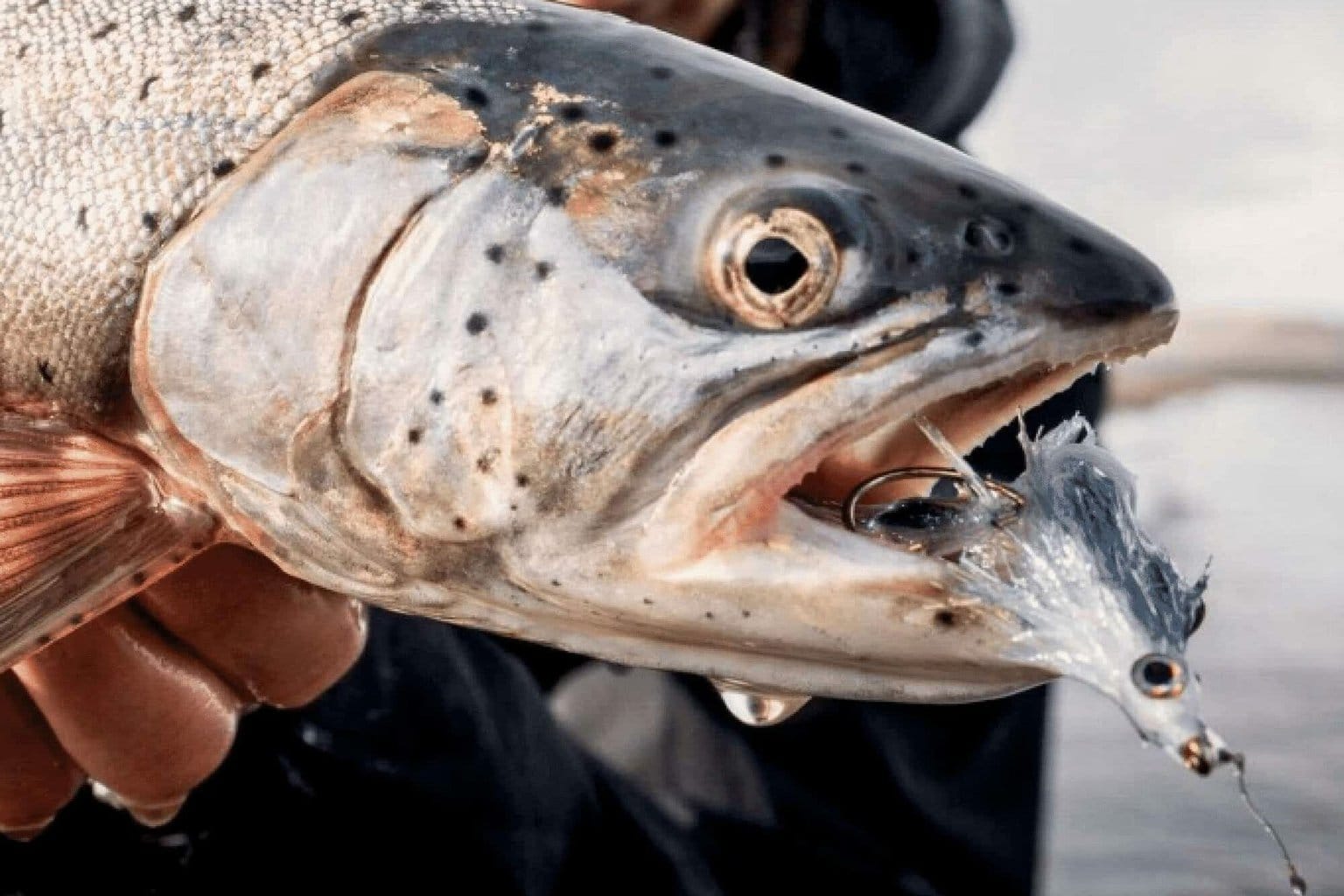
Streamers
Streamer flies are subsurface fly fishing flies that are frequently fished with motion or a slight retrieve to imitate larger food sources such as baitfish, minnows, crayfish, and more. Because streamer flies are heavier and larger in size, they are usually fished with a heavier rod and fly line to make casting easier. They are often fished with tight lines and a quick, slow, or erratic retrieve. They are similar to a spinning lure, in the sense that you are retrieving it back to you and you are trying to cover large amounts of water.
Again, it does not matter if we know the specific names of fly patterns, we are looking for flies that match the size, shape, and color of what is in the bushes or on the water actively hatching. Having a well-stocked box with the right fly fishing flies is the last piece of the puzzle.
Recommended Reading: Fly Fishing Streamer Basics For Beginners Just Starting Out
Understanding Insect Life Cycles and Applying it to Fly Selection
Before we jump into what fly fishing flies we should choose for a day on the water, it helps if you have a general understanding of fly fishing entomology. Insect’s lifecycle and different life stages dictate where and how you will fish. Again, anglers tend to believe it sounds really cool to drop Latin names on the river or in the fly shop, but the fish don’t care. Most anglers roll their eyes and sigh a deep breath when the Latin names start coming out. Here is what you need to know. There are 4 general categories of aquatic trout food that most anglers will see streamside during the prime months of trout fishing: they are Mayflies, Caddis Flies, Stoneflies, and Terrestrials. Remember, focus on size, body profile, and color when selecting your fly type. This is a general overview of the different species and their different stages of development. A solid understanding what is happening above and below the water with the different insect species will help us choose the the right fly fishing flies.


Mayflies
Mayflies come in many sizes shapes and colors. The important thing to remember is that they have upright wings and a tail. There lifecycle is egg, nymphs, and adult.
Your most common mayflies are typically found underneath river rocks in shallow riffles. As they start to hatch, the nymphs crawl out from under the rocks. At this moment they hit the river current and tumble through the lower portion of the water column (this is what we are imitating when we are nymphing deep under a strike indicator). They swim to the surface of the river where they hit the meniscus of the water in attempt to crack open their skin shuck, and crawl out on the surface of the water. The meniscus is the tension formed by the surface water, and getting through this layer is a difficult task. This is known as the period of emergence. Mayflies and aquatic insects are vulnerable at this stage. It takes a tremendous amount of energy and struggling to break through the surface of the water. Once on the surface, they develop their wings and fly to the bank to reproduce.
Recommended Reading: What are the Best Casts for Dry Fly Fishing

Caddis Flies
Caddis Flies are the most prolific of all the aquatic insects. They are characterized by wings that lay down and resemble a pup tent. They are easy to confuse with a moth if you look at a glance. Their lifecycle is: egg, larva, pupa, and adult.
Caddis flies are very similar to mayflies in terms of their lifecycle. The main difference is that caddis flies are case builders. As case builders, the larval form of caddis flies construct small cases to live in and attach themselves to rocks and tree branches below the surface of the river. When they are ready to hatch they use air bubbles to help them swim to the river’s surface (an opportunity to fish soft hackle wet fly). Using long bursts of power caddis move vertically through the water column to hatch. The emerging caddis fly must break through the water’s surface to transform into the adult. They are vulnerable to feeding fish as they struggle in the surface film to reach the adult stages of the reproductive process. Once on the surface they either run across the water or fly to the banks to reproduce.
Recommended Reading: How to Catch Trout on Caddis Flies

Stoneflies
Stoneflies in general are larger insects than mayflies and caddis flies. They are characterized by their wings that lay flat on their body, they begin hatching in early spring when the water reaches 55 degrees. The adults live in the grassy banks, and when these bugs are really going, you cannot miss them. They are large and make an easy trout meal. It is important to remember that they are crawlers. The stonefly nymphs are found along the banks, and fishing flies tight to cover is where the trout are going to be found.
Stoneflies are found underneath river rocks. Stoneflies are crawlers. When they are ready to hatch, instead of swimming through vertically through the water column, they crawl along the bottom of the river to the streamside river banks. They are looking for grassy banks where they mate and start the lifecycle all over again.
Recommended Reading: How to Catch Trout on Stoneflies


Terrestrials
Terrestrials are pretty much everything else that you would find on the banks of your favorite river: grasshoppers, ants, beetles, cicadas, and we will even throw worms in this category too. They can provide some amazing opportunities for dry fly fishing toward the end of the summer when other hatches start to wind down.
Terrestrials live on the banks, and typically fall into or are blown into the water when it is windy.
Recommended Reading: How to Fish Terrestrials for Trout


Midges
Midges are one of, if not, the most important food source for trout. Adult midges are usually quite small and resemble mosquitos with their long legs, dark body, and extended wings. Trout feed on midges year round in their adult flying stage and their larva stage. Midge larvae are always present at the bottom of ponds, streams, and riverbeds. Depending on what decomposing organic matter they eat and hemoglobin molecules their bodies contain, colors can vary from a bright red to a clear color. Once these larvae are ready to emerge they drift up to the surface and wiggle free of the meniscus.
When midges are hatching the adults tend to clump together into little rafts of multiple midges until they take flight, which the Griffith’s Gnat imitates. You’ll find flying adults gathered on rocks and in swarms on above the water.

How to Determine What Fish Are Eating
Now that we have a basic understanding of the main categories of the aquatic food sources that fish will be eating and their lifecycle, we can make educated guesses on what fish are eating. Here are the steps I take when fly fishing and trying to figure out what fly types to use:
- The first thing that I do when I approach a new river fly fishing, is to take a quick walk along the banks. Shake the streamside bushes and see what insects fall out. Take note of the size, shape, and color.
- Identify what class of food source it is based on the wing and body profile (mayfly, caddis, etc.). Does it have upright wings like a mayfly? How big is it, and does it have wings that lay down on its body? What color is it?
- Once I identify what kind of insects are present in the greatest number, I look at the river and observe if fish are actively rising. Are there adult insects floating on the water? If so, I am going to fish a dry fly or dry dropper rig, if not then I am going to nymph fishing deep under a strike indicator.
- Now that we have taken time to observe the streamside conditions, we can start to make educated guesses on what will be the best fly pattern for fly fishing and where and how we will fish the flies
Congratulations! If your new to fly fishing or have been fly fishing for a while, but needed clarification on fly patterns and matching the hatch, you just did it! We did it without uttering any Latin words, or knowing any specific bug names!

Impressionistic Flies
If you are new to fly fishing, and it is your first-time shopping for flies than my recommendation is start with impressionistic fly patterns. Impressionistic fly patterns, are fly patterns that imitate a variety of insects and life cycles. Most impressionistic flies have a defined profile and are often tied in drab natural colors like grey, olive, or brown. The idea behind impressionistic fly patterns is to cast a wider net then flies that specifically match a hatch. We are looking for fly patterns that cover a variety of insects and life cycles. A good example of this would be your classic pheasant tail. We could select pheasant tails of different sizes. The smaller size pheasant tails pass for blue wing olive nymphs, P.M.D. Nymphs, or even yellow sally nymphs. As we move up in sizes, the same pheasant tail can be fished during a green drake hatch, golden stone fly hatch and even various caddis hatches. These are excellent flies to fish in faster water because the window for fish to make a decision on whether they want to eat the fly or not is very short. This class of flies covers a wider range of scenarios, so they are great to have when you are fishing rivers where you do not fish often. They are also effective when you are fishing before hatches start.

Imitative Flies
Imitative flies are imitating a specific insect in a specific part of the life cycle with great detail. You want to have a good selection of imitative flies in the fly box. As hatches develop, fish become keyed into eating both the adult stage and nymph stage of the hatch. Fish reach the peak of their selectiveness, and not having hatch specific flies is a horrible feeling when fish are eating dry flies at the surface. Fish seem to be eating everything on the surface except your fly! Many times they won’t eat an impressionistic fly, they are too keyed into the characteristics of a particular insect. Your fly needs to match those characteristics exactly.
On larger western rivers in the West, like the South Fork of the Snake, the P.M.D. hatch happens daily and you can set your watch to it. This is a scenario where you know that the fish will be looking specifically for the right size, profile of a P.M.D., color, and place in the water column. They get pickier as the fishing pressure increases too.
When I am guiding on the South Fork, one fly I always keep in my fly box is a split case P.M.D. This fly is imitating an emerging P.M.D. mayfly. It can be a nymph fished deep, or you can put it behind a small dry fly with a greased tippet to make it hang in the surface film. Imitative flies are effective patterns to fish in slow flat water. Especially, for rising fish that are selectively eating during a hatch. Trout have time to study the fly in these situations, so it is important that it looks just right. On super technical fisheries like the Railroad Ranch section of the Henry’s Fork, you can have the right fly size and shape, but it still will not be eaten. The trout are selective because they study the flies, are heavily pressured and are into just the right color of bug.

What Flies Should I Use If There Is No Hatch To Match
If you arrive at your favorite river to fly fish and you have no idea what to fish or there are no bugs actively hatching, then an attractor pattern or searching pattern is a solid choice. Most flies in this category are effective for imitating as wide a range of food types as possible. Typically, they are tied with shaggy materials like squirrel fur or rabbit fur dubbing. They are intentionally going for a “buggy” look, with a less defined profile. These flies could literally be anything. A great example of a searching pattern, would be a hare’s ear. A hare’s ear could be a caddis, mayfly, small stonefly…you name it. It covers them all, and they are typically tied in neutral colors. Although they are not flashy searching patterns work well. Fish these when no bugs are present or you have no idea what might be working on a new river.
If no bugs are present, go for a reactionary strike and use an attractor pattern. Attractor patterns are similar to searching patterns. The difference is that these flies are tied with an exceptional amount of flash. The purpose of the flash is to grab the fish’s attention and create a reactionary strike. Attractor patterns work exceptionally well in fast water. Rainbow warriors are classic examples of an attractor fly.
In addition, if you are fortunate to fish in rivers with cutthroats, then you are going to want to have a wide array of attractor patterns in your fly box. Rainbows, browns, and cutthroat trout will all eat attractor patterns, but cutthroat trout enjoy eating attractor dry flies the most. They are curious by nature and for whatever reason, they just enjoy eating flashy dry flies. In the Snake River drainage of Idaho and Wyoming, attractor patterns are heavily fished and are a favorite of most guides.
What Flies Should I Choose?
After all that information, hopefully you have an idea of the style of freshwater flies you might want to choose when picking fly fishing flies to match the hatch. If I was going fly fishing today I would have a well rounded selection of wet flies, dry flies and foam patterns. I have put together a list of flies that I would not leave home without. These are fly patterns that are must have fly fishing flies in any anglers fly box. A fly angler should not leave home without these flies.
Attractor Patterns

Jig Head Rainbow Warrior
The rainbow warrior is a great pattern when it comes to attractor flies. It just plain works. Especially in the jig head form. I am nots sure why jig head flies are more effective, but they do catch more fish in my opinion and experience. I believe that the reason for this is that depth is the single most important factor when nymphing flies subsurface. My theory is that jig head flies get the fly down quicker and it stays in the strike zone longer. More time underwater, means more chances to catch fish.

Perdigon
The perdigon was developed in the competitive atmosphere of European nymphing. It get’s down fast and is very effective fished on a dry dropper rig, with European nymphing techniques, or off a point fly nymphed deep under a strike indicator. Buy lots of these in various forms: Spanish Perdigon, Yellow Perdigon, Jiggy Perdigon, Zebra Perdigon, etc. etc.

Psycho Prince Nymph
No body can tell you why the prince nymph is so effective, It doesn’t look like anything in the water. The psycho nymph in purple and the fly formerly known as Prince are both phenomenal attractor patterns that take an already great pattern to the next level.

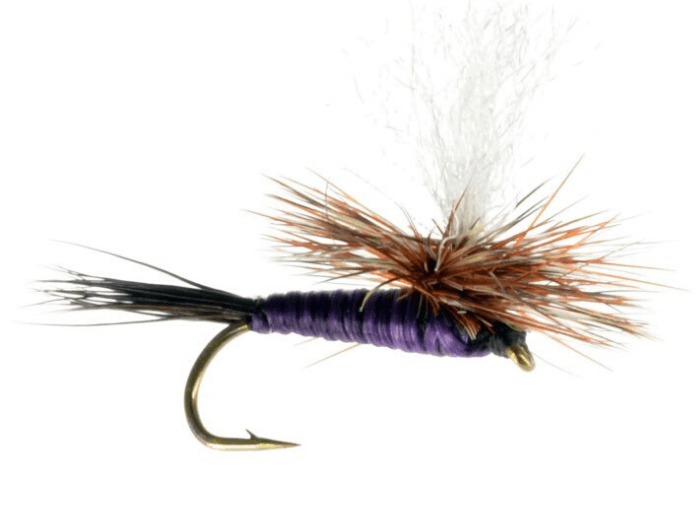
Patriot Fly and Purple Haze
Both are great options when looking for an attractor dry fly. We like to use these to scout for trout on open runs, along stream banks, and along bubbly seamlines. They don’t imitate any mayfly species in particular but they do present a perfect mayfly silhouette.

Green Weenie Jig
Not sure why this works, but it does. These have long been one of the best-kept secrets on the competitive fly fishing circuit.
Searching Patterns


Jig Head Hares Ear or Honey Badger Jig
Both flies cover a wide range of most insects and hatches. Tied in the smallest size #20, they even work well year round in the winter and cover midge hatches. Furthermore, they get deep and stay there. You could cover a lot water fishing situations with these two flies.

Parachute Hares Ear
It just looks buggy and even more so when it is hanging in the surface film. Color these with a permanent marker if you need them to be more hatch specific.

Parachute Adams
Everybody should a full range of sizes of Parachute Adam’s in their fly box for dry fly fishing situations. Trout love this dry fly and it could literally be anything. Wise fly angler’s alway carry an assortment of permanent markers in their vest. If you buy Adam’s in a grey color, you can color them on the water to better match the hatch if it gets technical.

Stimulator
The stimulator is great because they cover caddis flies in smaller sizes as well as stonefly and the larger salmon fly hatch. They can also be used to fish terrestrials hatches like grasshoppers, crickets, and other large flying insects. Stimulators are packed with stiff hackle and a dense elk hair wing, which allows them to float while supporting a decent amount of trailing weight below.
Impressionistic Flies

Pheasant Tails
Carry a variety of pheasant tails: unweighted, jig head, flashback, and euro style. One of my favorite pheasant tail patterns is the Frenchie. Pheasant tails with a hot spot tied into the collar can be helpful in stained water or when you find picky fish. You can even use small unweighted pheasant tails on a greased leader to imitate emerging mayflies in the surface film. They are very versatile flies.

Pat’s Rubber Leg
Pat’s rubber leg can always be run as a point fly to get your fly rig deep with a two-fly rig fished under and strike indicator. Fish could see this pattern as a stonefly, flav or green drake nymph. They work well. Do not be afraid to try orange and black color combinations, and even blonde.

Mop Fly
This grub larva works well when fly fishing tailwaters where both crane flies and salmon flies are present. We like to fish these when flows are high because the current will cut into the muddy banks and sediment layers pushing larvae loose. But, they also work well just about any other time.

Elk Hair Caddis
This is one my favorite dry flies, and I have even caught fish on them nymphing them deep as wet flies. I think they look like drowned adult mayflies or caddis flies, and they even look like a soft hackle wet fly. Caddis flies are usually the most prevalent insect in the river, so it is always a good idea to try an elk hair caddis. Fish feeding on caddis flies usually create a splashy rise form.

CDC Cinnamon Ant
The cinnamon ant is also a great impressionistic dry fly. It could be a crippled may fly, an ant, or a small brown caddis fly. Whatever trout think it is does not really matter because they are great at catching fish.

Chubby Chernobyl
The Chubby Chernobyl is a foam dry fly pattern that fish love, and they float other flies well. This is an excellent choice when looking for a fly that will cover both terrestrials and stoneflies and salmon flies.
Imitative Flies

Split Case Emerging PMDs and BWO’s
Two of my favorite flies can be fished as a wet fly deep or in the surface film when matching the hatch. The difference between fishing it deep or in the surface film is weight. The heavier pattern with a weighted body and beaded front will plunge it down within feeding zones. However, an unweighted Split Case PMD or BWO will drift effortlessly just below the surface. The best way to do this is with a tight-line method or on a short trailer below a dry fly or strike indicator.

Squirmy Wormy’s
This is a phenomenal springtime fly when the water is dirty and there are annelids in the water from washed out banks. Use this a point fly and then drop something small off it, like an egg or pheasant tail.

Juju Baetis
This fly has a slim profile and works well on technical tailwater fisheries as a subsurface wet fly and as an emerger

CDC Compara Dun
Dry fly CDC Comparaduns work well in a variety of situations. This is one of my favorite dry fly mayfly patterns to match the hatch when fish feed on both adult and emerger mayflies. This fly sits lower in the water, so it can be confused as a dry fly emerger or adult.

Dave Hopper
This is my all-time favorite fly. Fish tend to eat this with reckless abandon. Fly fishers should have this pattern with them. I have even used them to catch saltwater species at the coast in lieu of more traditional saltwater flies.
Fly Fishing Made Easy 👍
Our Quarterly Fly Club ships 1,000’s of flies to anglers all across the United States. Receive curated fly assortments selected for the season with in-depth articles on how to fish them. Great for beginners to learn and for intermediates to discover new flies.

